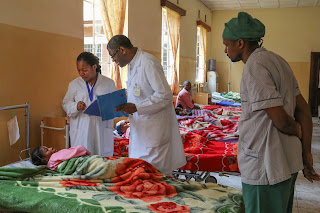Its goal was
to bring together leading intellectuals and artists from Africa and the diaspora, and, 50 years ago, the first Festival Mondial des Arts Nègres (World
Festival of Negro Arts, or FESMAN) did exactly that.
 |
| Leopold Senghor, centre, at the start of the festival. (Photo: from Jean Mazel. Collection PANAFEST archive) |
It included
some world-renowned headliners: writers Wole Soyinka, Aimé Césaire and Langston
Hughes; musician Duke Ellington; dancers from the Alvin Ailey troupe; iconic singer and activist
Josephine Baker; calypso star Mighty Sparrow – and many others,
representing some 45 countries.
The festival showed the world the wealth of African art and culture, and people got a
clear taste of the rivalry between the superpowers of the era, as Russia sent
a steamship to Dakar with about 750 passengers who participated in a festival
that was attended by a large American delegation, underwritten by the U.S. State Department.
That back
story, and the history and impact of the festival are now being highlighted in
an exhibition that runs until May 15, 2016, at the Quai Branly Museum in Paris.
The show, titled "Dakar 66: Chronicles of a Pan-African Festival", presents film archives, posters, magazine articles and photographs, and it captures the ambience of the event and the
times.
 |
| Dominique Malaquais (photo: McKenzie) |
The three
experts had worked respectively on projects dealing with four of the major pan-African
festivals to date, and on the role of Présence Africaine, the famed journal
that began in 1947 in Paris and whose publishers helped to organize the Dakar
festival. So they came up with the idea to focus on film, interviews and
publications, with “specific entry points”, Malaquais said.
The
exhibition begins with the official representations of the festival – such as
the striking poster created by Senegalese artist Ibou Diouf, which later caused
controversy because it was seen as an emblem of the Negritude movement – and it
moves to videos of the speeches given by Senghor, Césaire and also André Malraux,
the celebrated French writer and France’s first Minister of Cultural Affairs.
 |
| An article about the festival, in a U.S. magazine. |
“What
happened was that USIA, the United States Information Agency – one of the
diplomatic arms of the US government – in a very specific Cold-War bid to
present abroad a positive image of the United States that would counter Soviet
propaganda, commissioned this [Greaves' film],” Malaquais told SWAN.
“These films
were never shown in the United States, they were only shown abroad, and this
film was made to do something very particular from the USIA’s point of view,
not Greaves’ point of view,” she continued. “The idea was to show a picture of
the United States as open to the voices of the African American minority, which
of course in 1966 – no comment, right?
 |
| A journalist watches the Greaves film. |
Each film has
its own ideological perspective as Russia was keen to highlight the United
States’ history of slavery and its continued oppression of its black
population, according to the curators. Carefully sub-titled in French, the
Soviet film is being shown for the first time in France, and viewers can watch
both presentations and draw their own conclusions.
 |
| A shot from the Soviet-made film. |
“You can see
the ways in which the festival was implicated in larger global and Cold-War
issues,” said Malaquais. “People tend to think of these great pan-African
festivals as something localised, and they weren’t. They were worldwide events
with international repercussions. And that’s what we wanted to express with
this exhibition.”
Museum-goers can
see illustrations, too, of the huge colloquium held at Senegal’s parliament
house, on the “Function and Significance of Black Arts in the Lives of the
People and for the People”. This attracted hundreds of observers and
international experts from the worlds of literature, art, film, music and other
fields, under the auspices of UNESCO.
 |
| Malaquais and Marie Laure Croiziers de Lacvivier, Senghor's niece, with two visitors at the exhibition. (Photo: McKenzie) |
“It’s a real
mix,” Malaquais said. “We have an example of a medal that was given out at the
festival, and there are key-chains that were publicity items, for instance. And
there are advertising brochures for Air France and for the Russian steamship.”
One of the
highlights of the exhibition is the slideshow of blown-up photographs, made available
to the curators by a private collector named Jean Mazel and by a photographer
who travelled to the festival as a young man. These pictures bring home the
fierce motivation of the leading characters of the festival, many of whom today
remain larger than life. – A.M. Copyright SWAN. Follow us on Twitter: @mckenzie_ale












